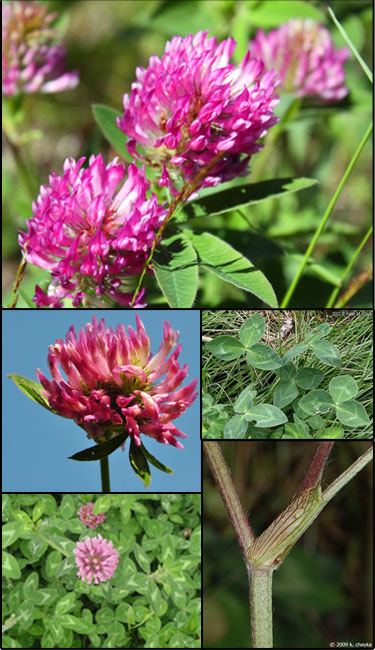Red clover (Trifolium pratense)
 Synonyms: Trifolium pratense L. var. frigidum, Trifolium pratense L. var. sativum
Synonyms: Trifolium pratense L. var. frigidum, Trifolium pratense L. var. sativumDescription: This plant is capable of nitrogen fixation, It is commonly grown as a fodder crop. Also cultivated for its medicinal properties.
Habit: Erect to drooping; perennial with trifoliate leaves; 1-3 ft tall forb; stems with close hairs; fibrous root system.
Leaves: 3-parted; elliptic in outline; 1/2-1 1/4 in long, half as wide; hairy on both surfaces; green or white "V-shaped" marking; lower leaves on long stalks, upper leaves with short stalks or stalkless.
Stems: Growing somewhat prostrate but ranging from 8 - 20 inches in height; sometimes without hairs but can be slightly hairy, and root at the nodes.
Flowers: Red to pink in color, 5-parted, 1/2-3/4 in long, calyx is 2 lipped, inflorescence is a 1 1/8 in round head of stalkless flowers.
Fruit and seeds: A pod known as a legume, 4 to 5 mm long.
Habitat: Native to Europe, Asia and North Africa. Found in disturbed areas, dry roadsides, fields, meadows and waste places in the lowland, steppe and montane zones.
Reproduction: By seed.
Similar species: White Clover (Trifolium repens) is similar but is generally more prostrate, smaller leaflets and smaller flowers.
Monitoring and rapid response: Effectively controlled using any of several readily available general use herbicides. Credits: The information provided in this factsheet was gathered from the Robert W. Freckmann Herbarium, the USDA PLANTS Database and the Virginia Tech Department of Forest Resources and Environmental Conservation VTree.
Individual species images that appear with a number in a black box are courtesy of the Bugwood.org network (http://www.invasive.org).Individual photo author credits may not be included due to the small display size of the images and subsequent difficulty of reading the provided text. All other images appear courtesy of Google (http://images.google.com).
